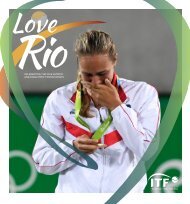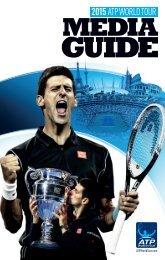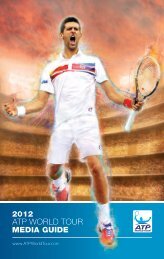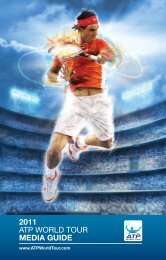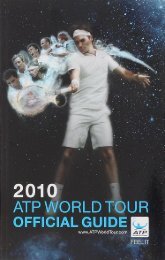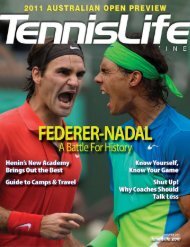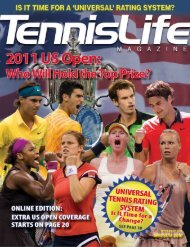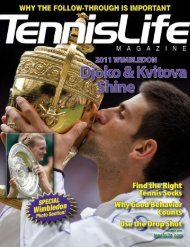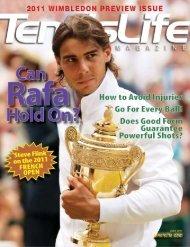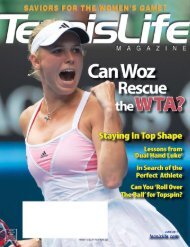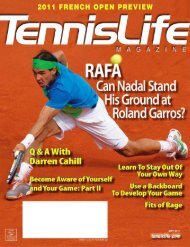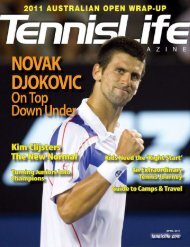A Champion's Mind - Pete Sampras
www.tennismoscow.me Insta:TENNISMOSCOW
www.tennismoscow.me Insta:TENNISMOSCOW
Create successful ePaper yourself
Turn your PDF publications into a flip-book with our unique Google optimized e-Paper software.
I went into 1993 determined never to give up in a match again. Whatever happened, I would never lose<br />
another battle—especially a Grand Slam final or similar big opportunity—because I didn’t have the heart<br />
to fight to the finish and walk off the court spent. I’d had my conversation with commitment; now it was<br />
just a matter of backing up my promise on the court.<br />
As the year developed, I felt I was right in the mix of top players, and enjoying the game more than<br />
ever. I lost to Edberg in the semis at the Australian Open, where he always played well and I did not. I<br />
won Philadelphia, Miami, Tokyo, and Hong Kong, and claimed the number one ranking on the computer<br />
for the first time in my career. It was a controversial ascent because I became number one by winning<br />
everything but slams. Still, I was hardly to blame for the way the ATP computer allocated points, and I<br />
was clearly the most consistent player in the early part of the year.<br />
It rankled me that I had yet to win my second major, while Jim Courier by then had a whopping four<br />
(two at Roland Garros, two from the Australian Open). He’d taken command in our generation (Michael,<br />
Andre, and I had just one major apiece), and I was determined to regain my place at the top of our pecking<br />
order. It was more important to me than the computer rankings.<br />
I turned in a good clay-court season, putting up wins over Alex Corretja, Andrei Cherkasov, Guillermo<br />
Perez-Roldan, and some other clay-court experts. At Roland Garros, I lost in the quarters to the eventual<br />
champ, Sergi Bruguera. Then it was on to the grass: I went on to Queen’s Club and lost in the first round<br />
to one of those accomplished South African grass-court players, Grant Stafford. But that wasn’t so bad,<br />
because I never did well at Queen’s in the years when I was in the hunt at the French Open. This had less<br />
to do with having to make the transition from clay to grass than the letdown I always felt after missing a<br />
chance to win a Grand Slam. I needed time to recuperate, emotionally and mentally, from a major<br />
campaign—especially one that was unsuccessful.<br />
I was one of the clear favorites going into Wimbledon in 1993, and not just among the pundits and London<br />
bookmakers. This time I was comfortable with the expectations, and I wanted to win. One of my major<br />
goals when I hired Tim was figuring out the grass-court game, and we worked on that, in various ways,<br />
from the onset of our relationship. We felt that the early loss at Queen’s Club could be helpful, because it<br />
meant we had almost two full weeks of valuable extra time to iron out what we both hoped were the final<br />
kinks in my redesigned Wimbledon game.<br />
When my brother, Gus, and I first arrived at Wimbledon in 1989, we’d gone straight to Centre Court<br />
and just sat there, taking it all in. Centre Court—it had such a huge impact on me as a child that years<br />
later, as a young pro, I was almost shocked to see that the place really, truly did exist. And it was much<br />
smaller than Gus and I had imagined. We just sat there for ten minutes, drinking in the sight of the empty,<br />
quiet stadium and gazing at that cool, inviting, emerald green grass. This was the place where, as we’d<br />
watched, John McEnroe had won; this was the place where Laver had played all those matches—on our<br />
living-room wall.<br />
But there was this little problem of actually having to play on that grass, instead of merely watching<br />
others do it. And that problem was relatively simple: I could hold serve easily and still lose matches 7–6,<br />
7–6, 7–6. Despite the hype, grass-court tennis isn’t about the serve; it’s all about the return. My game was



